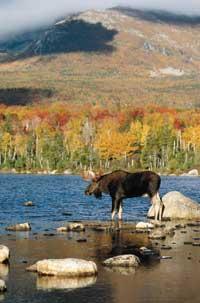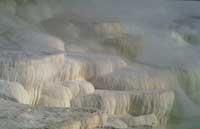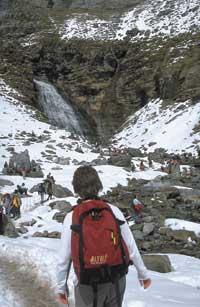Protected spaces in the world

Currently there are 30.350 protected spaces in the world, with a total of 13.232.275 km 2. In other words, 8.83% of the land area, that is, approximately the equivalent of China and India, according to the data obtained by the NNF and, in some cases, taking into account that within these protected areas the parts of the sea have also been counted. In addition, there are other 30,000 spaces that do not fully meet the status of protected spaces.
Definition problems
Protected areas are designated and managed with various reasons and purposes for the protection of wildlife, ecosystem and species conservation, scientific research, tourism, education, sustainable exploitation of natural ecosystems, preservation of their cultural characteristics, etc. In fact, protected space is not necessarily a natural space isolated from human beings. In non-industrialized countries, for example, most natural parks were designated to attract international tourism.
By their own criteria, from the beginning there have been problems for the designation and classification of protected spaces. Proof of this are the 1,388 terms that exist to describe them, but here we do not begin to list all. The classic example is that of the national park. In America, Africa, South and East Asia, Australia and New Zealand, national parks are large and natural, while many Europeans have evolved in the interaction of man and nature. All of England and Wales, most of Germany and the Cevennes and Danube national parks of France and Hungary are of this type.
In 1948, promoted by the United Nations, the International Union for the Conservation of Nature and Natural Resources (IUCN) was created, which since then has been in charge of defining the main rules and guidelines on protected spaces. The UN is composed of 78 states, 112 government organizations and 735 non-governmental organizations and has 10,000 scientists from 181 countries. The UN establishes models and adapts them to their peculiarities.
Within the objectives, the UN distinguishes six categories: scientific reserves and integral natural reserves, national parks, natural monuments, corrected natural reserves, protected landscapes and resource reserves. In any case, these categories should not be classified hierarchically. In short, all categories are important for the protection and conservation of biodiversity.
Fragmented ecosystems

In recent years, most countries have adopted protection policies that aim to maintain and protect several natural spaces close to their original state. However, this is not a work in any case, although protected, since the list of threats is endless: pollution and climate change, indifferent tourism, greater need for land for infrastructure and agriculture, population increase, wild development, wars, abandonment... Because our modern society has developed at the expense of nature and now it is not easy to turn it around.
To begin with, the world is full of people. In 12 years we have gone from 5 billion to 6 billion. The Earth has not increased, but the pressure on nature and conservation theories are difficult to meet. According to them, protected spaces should be as wide as possible, since depending on their size it is easier to maintain the characteristics of the region, highlight the presence of ecological communities and prevent species extinction. In theory, the older they are, the better they can relieve outside pressure. However, 59% of protected areas in the world do not reach 1,000 hectares and only account for 0.2% of the protected area. On the contrary, 6% of the protected areas corresponds to 87% of the protected area, i.e. 11.56 million km 2.
Due to the small size of most of the rest, networks of protected spaces have been created to join forces and prepare natural corridors between zones. Corridors aim to ensure physical contact between habitats and limit ecosystem fragmentation to facilitate the migration of plants and animals. In addition, according to some studies, one-fifth of the world's largest natural reserves can have a totally different landscape within 30 years due to climate change.

This transformation of the place of residence can endanger the survival of species and corridors can be a solution. In Europe it is intended to create "reserve networks" for animals that move from one habitat to another and it is suggested to use as corridors the land of the power lines that cross the whole country of Israel. Few of these ideas have gone from paper to reality. And it is that people who have to take care of protected spaces have problems of greater immediacy and climate change is a challenge that appears very far on the horizon.
In the United States, for example, they have serious problems with tourism. The culture of national parks has taken root in local society and more and more people come to enjoy the landscape and leisure they offer. Each year they receive 270 million visitors and although they leave money, they destroy natural resources. To avoid it, it is necessary to delimit and regulate human activities, since in short the parks have not been specifically intended for tourism. Or yes?
Through protected spaces society is shown to have moved away from nature its values, but it is evident that the conservation of nature and tourism are difficult to combine. It has recently been known that the Panda habitat is being destroyed more slowly than in the China Nature Reserve created specifically to protect the panda habitat in unprotected areas, and that the speed of destruction has increased since the declaration of the reserve. Panda and man love the same habitat and, according to researchers, there is the key to destruction. In fact, in 25 years the human population of the reserve has grown 70%, since being ethnic minorities can have more than one child and since it was declared park the economic situation has improved, the reserve has brought with it tourism and tourism money.
Reserves for peace

Borders and conflicts are also a great threat. Approximately 10% of the protected area is between states and requires cross-border cooperation. The NKNB gives them special relevance, since in addition to serving as a channel to preserve politically distributed ecosystems, they promote international cooperation at the political and scientific level. In this sense, the UN has a project called “peace parks”. On the one hand, because in countries where poverty and conflict are serious, it is difficult to make policies on protected spaces and, on the other hand, because they consider that transboundary protected spaces can be an instrument to overcome the painful political, economic and social situation of many regions.
On the Virunga Mountains, on the border between Rwanda, Uganda and Congo, borders and conflicts come together. Each State manages as a national park its share, but the gorillas that inhabit its interior do not know physical borders between countries. Being a very touristic place, it was an excellent source of income until the beginning of the civil war in Rwanda. Since then, refugees who fled to the Virunga mountains have destroyed 150 km 2 of the forest and cured animals without distinction. The park's infrastructure was destroyed and remained almost unguarded for 7 years. In addition, the military activity was intense in the park. The situation has not improved much in Rwanda and the Virunga mountains continue to bear strong demographic pressure, as it is not easy to tell people that the most basic thing that the park has to maintain in their state is missing.
In this situation it is essential to combine protected space with sustainable development. Just as the development of society within nature is illicit, because the conservation of nature cannot be separated from human development.
General classification of protected areas
Integral natural reserves
(7% of the total protected area) and Wild Zones (7%): the main objective is the conservation of communities and species and always discarding the direct participation of man in natural processes. In addition, as the main objective of regional basation is the scientist, the human presence will be limited to this activity. The activities of indigenous peoples in the Wild Zones are not prohibited.- National Parks (30%): The management objective of this category is to protect the natural landscapes in which representative national or international ecosystems or landscapes have been preserved to carry out educational, leisure and scientific activities.
- Natural monuments (1%): within this category the natural spaces (geological formations, singular natural spaces...) that the human being has hardly changed, are in danger or are exceptional are preserved and protected.
 In the mountains of Virunga the habitation of gorillas is in danger.
In the mountains of Virunga the habitation of gorillas is in danger.
* Corrected natural reserves (19%): They are the biotic communities of national importance and the areas designated for the protection of species and the maintenance of the necessary natural conditions and, if necessary to achieve the objectives, direct human participation is legitimate. The only activities of these spaces will be scientific research, education and permanent care.
- Protected landscapes (8%): On the one hand, the areas of this category are characterized by a balanced relationship between the human being and the environment that develops within the life and normal economic activity of the region, and on the other, by its potential for leisure and tourism.
- Resource reserves (27%): will be preserved and protected resources that will be useful in the future. The areas of this category are generally broad, isolated and unpopulated. Protection, research and planning will be urgent tasks.
Other protected spaces
- Anthropological reserves: it is about getting societies that live harmoniously with the environment in the areas classified in this category, to continue with their lifestyle, except the influence of modern technology. The maintenance of genetic diversity and the knowledge of human evolution are some of the reasons for these reserves.
- Multiple Use Zones: They are extensive areas of forests and mountains that, in addition to being suitable for exploitation by sectors such as forestry, water, meadows, animals or leisure, can be colonized to some extent by humans, always under sustainable exploitation.
- Biosphere Reserves: It is appointed by UNESCO and aims to designate the international network of biosphere reserves. The international spaces of this category, in addition to the classic natural part, are constituted by stable ecosystems and degraded by the human being and always present one of the following characteristics: they are spectacular examples of natural communities, they have a singular or singular part, they are stable landscapes or degraded ecosystems.
- Natural sites of world heritage: it is about protecting, through the places that will become world heritage, the steps of Earth history, current geological processes, biological evolution, the interaction between man and his environment, or excellent samples or examples of habitats with singular plants or animal communities.
(Conservation of the EU, nature, where are we going? adapted from the book)
Buletina
Bidali zure helbide elektronikoa eta jaso asteroko buletina zure sarrera-ontzian











